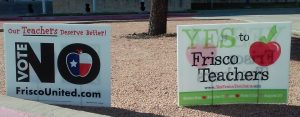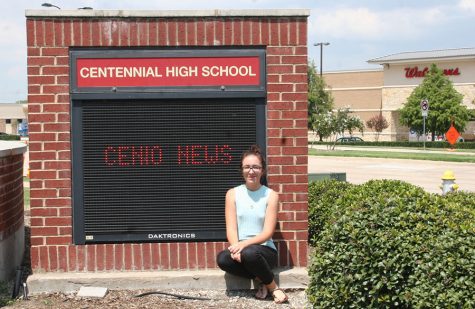What’s Next for Frisco ISD?
FISD board members roll up their sleeves to plan for budget savings.
The FISD school board.
September 9, 2016
The Frisco ISD Board of Trustees met in special session Tuesday, Sept. 6 to discuss the 2017-2018 school year budget development and propose budget savings for this year. This comes after the Tax Ratification Election that was set to increase property taxes for more FISD funding failed Aug. 29.
With all the signs gone, it appears most forgot about the issue. However, that’s not the case for FISD teachers, concerned parents and even students, as it’s set to have major implications for the future. Many are now wondering: what’s next?
During the special meeting, the board discussed a plan of action for this year, including prioritizing savings where possible within the already adopted budget, reducing staff travel, reducing professional development and scrutinizing hiring and utilizing the fund balance as necessary.
FISD School Board President, Anne McCausland, says the 2017-2018 school year will be one of tough decisions and tough choices, as the school districts tries to alleviate the projected debt of 10-12 million dollars left by the ASATR (additional state aid tax relief) that will totally go away in 2017, leading to a loss of about 30 million dollars for the district.
“We are doing everything we can to minimize the impact in regards to the classroom and then also to affect the staff,” McCausland said. “We’re doing our absolute best.”
A possible way to do that is to delay the opening of new schools until 2018-2019. There are currently four new schools under construction scheduled to open for the 2017-2018 school year―two elementary schools, one middle school and one high school. Staffing these schools would cost $15,182,250, while delaying opening them would save about 10-12 million dollars. However, the decision on whether to delay them or not (which has been done in the past in FISD, with Lone Star High School and Griffin Middle School) must be made soon as it has rezoning implications.
A delay might also affect class sizes at the existing schools as there are ramifications in regards to population at the schools they’re scheduled to relieve, an issue that has many teachers and students worried. McCausland says that while it’s going to be more difficult to manage class sizes, the board will do everything they can to minimize that impact.

“We have always tried to manage the class sizes, specifically at the elementary schools where we have the 22:1 ratio,” McCausland said. “It’s true class sizes may be a little bit bigger than what we had hoped but that is one thing we will have to face as a growing district.”
For the next school year, the board plans to reduce central administration costs as much as possible, freeze teacher salaries and reset the budget based on the priorities that will have the greatest impact on students while reducing spending in areas that don’t align with the priorities. A successful priorities based budget process will result in a balanced budget that is aligned with the district’s mission of knowing every student by name and need.
FISD’s priorities include protecting the classroom by guiding and supporting high levels of learning for all students, retaining an effective teacher in every classroom and an effective principal in every school, committing to the whole child by providing social, emotional, physical and academic support, providing a safe, secure and well maintained learning environment and continuing to maximize student opportunities through the small schools model.
However, some residents say FISD doesn’t have their priorities in order. Critical residents comment online that one of the reasons they voted no was because of Frisco’s “Taj Mahal” of an administration building, saying the money spent on that should have been used on students. McCausland, however, believes FISD does have their priorities in order. While she was not on the board when the decision to build the administration passed, she believes its building is justified.
“The Student Opportunity Center and the administration building were housed over on a small facility on Maple Street, and everybody who worked for the district was spread out in six different places because you couldn’t fit everybody in one location,” McCausland said. “We’re growing by 3500 students a year so the SOC has no more space. The administration and board met with the bond committee and said we’ve got a great opportunity and some land to build a facility to have everyone in one central location, which we think would be a cost saving measure. We thought it would be a wise investment for our community to have this facility.”
FISD also outlined their goals and visions for the future, along with a timeline of the next few months. The goals included: ensuring development and maintenance of the instructional program at the highest possible level of excellence while addressing the needs created by growth in the student population, prioritizing the distribution of funds to address the needs of the district in relation to both the academic and operational functions of the district and meeting the community standards and goals and objectives adopted by the Board of Trustees.
The board called for greater transparency with Frisco citizens and a citizen committee so that we can all be a part of the process. For those wondering if FISD will be able to remain one of the top school districts in the nation, rest assured as McCausland says she and the board plans to keep Frisco at the top.
“Our community expects excellence from our school district, and that’s a major reason why people move here,” McCausland said. “We intend to keep Frisco a district of excellence.”
The school board intends to enlist the help of FISD staff for identifying cost saving measures within the schools. Principal Dr. Alicia Maphies explains what the Centennial campus faces in the future:




